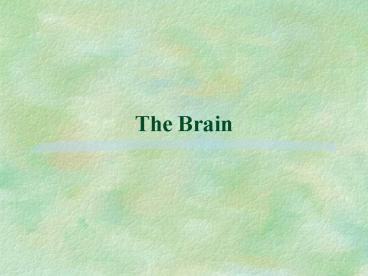The Brain PowerPoint PPT Presentation
1 / 18
Title: The Brain
1
The Brain
2
Some interesting brain facts
- Brain weighs 3 lbs
- However, it is completely immersed in liquid
(cerebrospinal fluid) and, as a result, its
effective weight is 3 ounces. - Brain uses 20 of the bodys blood, 20 of its
oxygen, and 70 of its glucose. - 80 of the human brain is cortex
- Cortex is virtually absent in fish, reptiles, and
birds - 1/3 of the cortex is visible
- Cortex is 1/8 thick and, if spread out flat, is
about the size of 1 sheet of newspaper (4 pages
of a textbook) - Localization of function vs. equipotentiality
(mass action) - Brocas area is in the frontal lobe when
destroyed, patient cannot produce language, but
can comprehend language Brocas aphasia - Wernickes area is in the temporal lobe when
destroyed patient cannot comprehend language, but
can produce language Wernickes aphasia
3
Direction in the brain
- We are symmetrical around our midline we have a
left arm and a right arm, a left ear and a right
ear, etc. - Medial close to the midline
- Lateral farther from the midline closer to the
side of the head
4
Some brain structure terminology
- Sulcus (pl. sulci) any of the shallow grooves
separating the convolutions (bumps, ridges) on
the surface of the brain - Fissure a very deep groove that, typically,
separates major cortical structures - Gyrus (pl. gyri) a convolution (bump, ridge) on
the brain surface - Commisures a fiber bundle that interconnects
corresponding regions on each side of the brain - White matter (mylinated axons) and gray matter
(cell bodies) - Cortical structures are specialized parts of the
cortex. - Everything else under the cortex, but above the
brainstem, is referred to as a subcortical
structure.
5
Some brain organization terminology
- Hemispheres
- The two relatively symmetrical halves of the
brain one on the left and one on the right - Contralaterality
- The left hemisphere receives sensory input from,
and sends motor messages to, the right side of
the body vice versa for the right hemisphere - Cerebral lateralization (hemispheric
specialization) - Instances in which one of the hemispheres is more
responsible for a particular cognitive function
than the other hemisphere - Left hemisphere specialized for language and
analytical thought - Right hemisphere specialized for visual-spatial
tasks, music, face recognition, and emotional
states - Cerebral dominance
- In 90 of human beings, the left hemisphere is
specialized for language and these individuals
are right-handed thus, the left hemisphere is
said to be the dominant hemisphere
6
Brainstem
- Medulla
- Vital involuntary functions
- Pons
- Sleep and arousal
- Reticular formation
- Sleep, arousal, attention
- Cerebellum
- Motor coordination
- Also involved in planning, memory, language, and
emotion
7
Another view of the brainstem
8
Limbic System I Emotion and motivation
- Hypothalamus
- Regulates
- Glands
- Autonomic system
- Eating
- Drinking
- Sleeping
- Sexual activity
- Plays a role in emotion
- Amygdala
- Forms learned associations between objects and
emotion, especially fear
9
Limbic system II Cognitive functions
- Thalamus
- Sensory relay station
- Hippocampus
- Formation of new memories
- Basal ganglia
- Putamen, globus pallidus, caudate nucleus
- Motor behavior
- Habit learning
10
Another view of both the limbic system and brain
stem
11
(No Transcript)
12
(No Transcript)
13
Neglect Syndrome (Hemineglect)
- A patient with a stroke in the right hemisphere
was asked to copy the model drawings - Typical of neglect syndromes, the left side of
the model is almost completely ignored
14
Primary motor cortex and somatosensory cortex
15
The Corpus Callosum
- Millions of myelinated axons connecting the
brains hemispheres - Provides a pathway for communication between the
hemispheres - If surgically severed for treatment of epilepsy,
hemispheres cannot communicate directly
16
Visual Processing
- Both eyes send information to both hemispheres
- Right half of the visual field goes to the left
hemisphere - Left half of the visual field goes to the right
hemisphere
17
Sperrys Split-Brain Experiment
- Split-brain subjects could not name objects shown
only to the right hemisphere - If asked to select these objects with their left
hand, they succeeded but they could not say why - The right side of the brain doesnt control speech
18
Brain Change
- Plasticity
- A property of the brain that allows it to change
as a result of experience, drugs, or injury - Chemical signals guide growing connections.
- Experience fine-tunes neural connections.
- Critical periods
- Rats in special environments have heavier brains
with more synaptic connections - Change in the strength of connections underlies
learning - Hebbian learning fire together, wire together
- Neurogenesis production of new brain cells in
the adult brain - Brain reorganization in response to overuse or
underuse - Devoting more cortex to information that is
pertinent for tasks at hand - Blind people who read Braille have much larger
areas of cortex devoted to receiving input from
index fingers than do sighted individuals - Brain reorganization in response to brain injury
- Much more likely to occur in the young
- Treatment for brain injury or disease
- Neural grafting, using stem cells

